I got an email a few days ago, courtesy of Santa Clara County’s Environmental Protection Agency, warning me that a plant I had purchased was part of a nursery delivery in which another plant tested positive for the pathogen that causes Sudden Oak Disease (Phytophthora ramorum). I was flabbergasted -- contact tracing for a plant disease! (And just as with covid, PCR tests are used to make definitive identifications.)
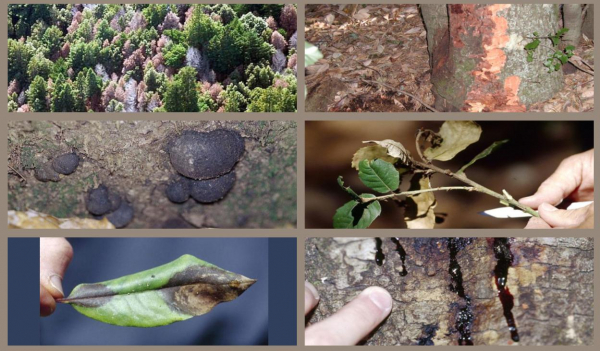
Signs of Sudden Oak Disease include bark cankers, leaf spots twig dieback, and “bleeding” on bark, often lower down. Photos from the United States Department of Agriculture, credit Joseph O'Brien, USDA Forest Service, Bugwood.org
It turns out that this pathogen poses a very serious problem for California native, and some non-native, trees and shrubs. Millions of California oaks have died from Sudden Oak Disease in the past few decades, and because the pathogen is a water mold that thrives in moist environments, this wet year may lead to many more infections. P. ramorum has been found in 16 counties in the state, including Santa Clara, San Mateo, and Alameda, typically in regions with fog or other moisture.
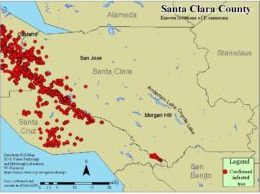
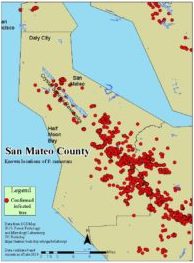
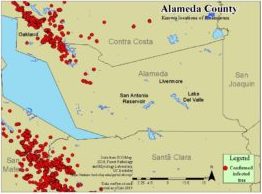
Maps showing where trees infected by P. ramorum have been found in Santa Clara, San Mateo, and Alameda counties (top to bottom). Data is from 2019. Source: California Oak Mortality Task Force
This pathogen has spread prolifically in the past. It came to California from overseas, then about 20 years ago some large west coast nurseries accidentally infected over 20 different states by shipping a million potentially infected rhododendrons and camellias. Plant varieties that host P. ramorum are now quarantined in 16 counties in California as well as in numerous countries around the world.
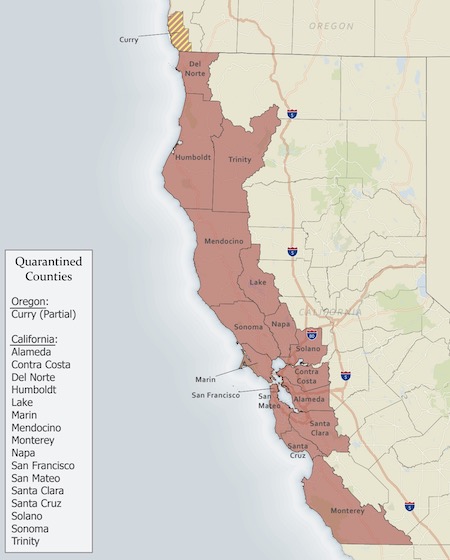
A quarantine for P. ramorum is in effect in 16 California counties and part of Oregon. Source: US Department of Agriculture
P. ramorum tends to kill only oaks, especially tan oaks but also coast live oaks, canyon oaks, black oaks, and Shreve oaks. It does not kill the white oaks like valley oak. It can also infect (but not kill) a wide variety of other plants, many of them very common in nature and/or nurseries, including camellias, rhododendrons, manzanitas, madrone, photinia, loropetalum, and more. These plants can serve as hosts for the pathogen, helping to spread it. Take a look at this long list of host plants, many of which you will recognize.
The worst culprit among the spreaders is the California bay laurel tree. Researchers have shown that oaks located near one of these infected trees are much more likely to get infected themselves and die. The picture below shows what an infected bay laurel leaf looks like. The leaves have brown spots where water settles, either at the tip or a leaf edge depending on leaf orientation. The dead area will probably have an irregular black line around it, then a yellow halo, with small infections in other parts of the leaf.
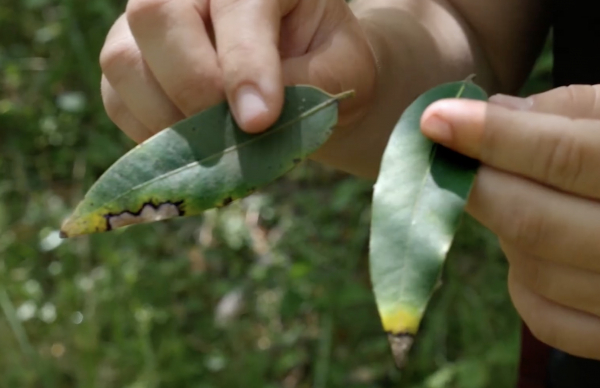
Infected bay laurel leafs have a dead spot where moisture gathers at the “bottom” of a leaf. There will typically be an irregular black line around it, then a yellow halo. Small infections that look like dots can sometimes be seen on other areas of the leaf. Source: Screenshot from video by UC Master Gardeners of Sonoma County
An infected camellia looks like this. Camellia plants will drop the infected leaves, leaving the lower part of the plant looking bare.
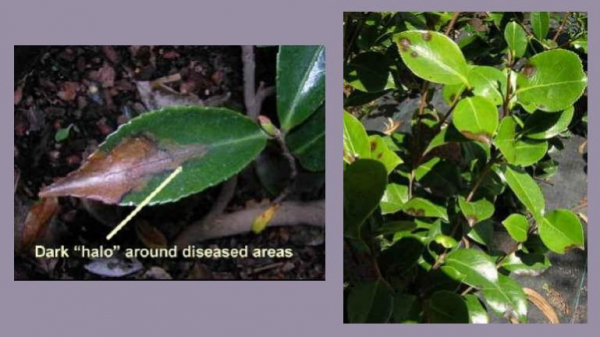
Photo source: California Oak Mortality Task Force, which has a gallery of photos of infected hosts.
If a vulnerable species of oak is located near an infected plant, and in particular near a bay laurel, it is cause for concern. If you notice a potential problem, check out this Homeowner’s Guide to Sudden Oak Death, or contact your county’s agriculture department.
There is no known cure for the diseases caused by P. ramorum. There is a fungicide that can help to prevent it and sometimes slow the progress of the disease if caught early enough. We can manage the spread of the disease by controlling infected hosts (e.g., dense stands of infected bay laurels), by not moving plant or soil material out of infected areas, and by inspecting host plants at nurseries. UC Berkeley also organizes citizen science patrols to spot problems.
Apparently the county is also doing contact tracing of infections. There have been some instances where restoration plantings have included infected nursery plants, thereby infecting previously uninfected natural areas. Luckily the plant I was notified of was just in my yard, seems to have avoided catching the disease, and is not near any oaks. But I’ll keep an eye on it.
Have you had any experience with infectious plant diseases like this? I’d love to hear.
Notes and References
0. I heard from several of you who thought I took the summer off from writing since you stopped getting notifications of new blogs. Well, it turns out the notifications were broken. They are working now, but if you did miss some blogs, you can find the full list here.
If you enjoy the more technical posts, you might check out the following. (The comments are often worth reading too.)
- Is it "Move fast and build things" or "Move fast and break things"? And when it's "break", who loses? (This is about carbon sequestration and the relevance of permitting.)
- Contrails and aviation emissions
- How to electrify a boiler
If you want to learn more about our power grid, you might try:
- How clean is our electricity?
- How reliable is our electricity?
- Palo Alto's Power Portfolio
There were these as well:
- "I didn't want to be 'that guy'" (Why do people not speak up about things they care about?)
- What I learned from my high impact yard project
- There is a new moon tonight. But will it be dark?
- How would you go about reducing our residential building emissions?
Current Climate Data
Global impacts (July 2023), US impacts (July 2023), CO2 metric, Climate dashboard
Comment Guidelines
I hope that your contributions will be an important part of this blog. To keep the discussion productive, please adhere to these guidelines or your comment may be edited or removed.
- Avoid disrespectful, disparaging, snide, angry, or ad hominem comments.
- Stay fact-based and refer to reputable sources.
- Stay on topic.
- In general, maintain this as a welcoming space for all readers.



